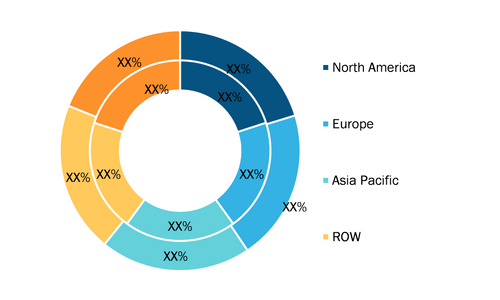Burgeoning Popularity of Connected Devices to Provide Growth Opportunities for wearable sensors market
According to our latest market study, titled "Wearable Sensors Market Forecast to 2028 – COVID-19 Impact and Global Analysis – by Sensor Type, Application, Vertical, and Geography," the market is expected to grow from US$ 1,906.74 million in 2021 to reach US$ 5,762.57 million by 2028. It is estimated to grow at a CAGR of 17.1% from 2021 to 2028.
The global wearable sensors market is segmented into five major regions – North America, Europe, Asia Pacific (APAC), and the Rest of the World. In 2020, APAC led the market with a substantial revenue share, followed by North America and Europe. The rapidly flourishing IoT landscape and miniaturization are trending in wearables technologies. Wearable technology integrates electronics into daily activities, thereby complementing the changing lifestyles. Wearable devices, including bodywear, wristwear, and eyewear, are being used in the healthcare and consumer electronic sectors.
wearable sensors market – by Geography, 2020 and 2028 (%)

Wearable Sensors Market Size and Industry Growth by 2028
Download Free SampleWearable Sensors Market Forecast to 2028 - COVID-19 Impact and Global Analysis By Sensor Type (Accelerometer, Gyroscope, Motion Sensors, Image Sensors, Pressure & Force Sensors, Touch Sensors, Position Sensors, and Others), Application (Smart Wristwear, Smart Glasses, Smart Bodywear, Smart Footwear, and Others), and Vertical (Consumer Electronics, Healthcare, and Industrial & Enterprise)
Source: The Insight Partners Analysis
With continuous and steady improvements in wearable technology, devices are becoming compact. A sharp rise in the use of smartphones and connected devices and the increasing need for smaller and lighter sensors with low-power requirements and enhanced performance are a few factors stimulating the trend of miniaturization.
STMicroelectronics, NXP Semiconductors, and Broadcom are some key players, which are investing heavily in R&D. Microvision (US) introduced the world's smallest and lightest display module PicoP scanning technology for smart glasses that utilize ultra-miniature MEMS mirror for scanning a modulated laser beam using state-of-the-art control systems. Thus, the increasing use of MEMS-, nanoelectromechanical systems (NEMS)-, and CMOS-based sensors is bolstering the wearable sensors market.
Moreover, the elevating cases of cardiovascular diseases (CVDs) worldwide is a key factor that is contributing substantially to the rising uptake of wearable devices. According to the American Heart Association, ~17.0 million people die each year due to cardiac abnormalities, and the number is expected to rise to ~23 million by 2030. PPG sensors typically measure oxygen saturation, blood pressure, and cardiac output through a series of waves and peak detection.
Further, the increasing number of connected devices is fueling the demand for wearable sensors. According to Cisco Systems, in terms of volume, connected wearable devices surged from 325 million in 2016 to 529 million in 2018, particularly in healthcare applications. This trend is expected to continue in the near future, aiding the demand for connected wearable devices. With increasing investments by various industries in IoT and IoT sensors, the need for wearable devices across multiple sectors is expected to rise and create a massive opportunity for wearable sensors market players during the forecast period.
The global wearable sensors market is assessed on four fronts: Sensor type, application, vertical, and geography. Based on sensor type, the market is segmented into accelerometer, gyroscope, motion sensors, image sensors, position sensors, pressure & force sensors, touch sensors, and other sensors. Based on application, the market is bifurcated into smart wristwear, smart glasses, smart bodywear, smart footwear, and other applications. Based on vertical, the market is classified into consumer electronics, healthcare, enterprise, and industrial. In terms of geography, the market is segmented into North America (the US, Canada, and Mexico), Europe (France, Germany, Italy, the UK, Russia, and the Rest of Europe), Asia Pacific (Australia, China, India, South Korea, Japan, and the Rest of APAC), and Rest of the World (Brazil, Argentina, UAE, and Other Countries).
Impact of COVID-19 Pandemic on wearable sensors market
The COVID-19 significantly impacted the electronics and semiconductors industry in 2020. According to Electronics Component Industry Association, the pandemic led to obstruction in the supply chain, cancelation of trade events, delay in product releases, and disruption in various other industry activities. Due to the containment norms, the electronics and semiconductors temporarily halted their operations.
Further, manufacturers of various electronics and semiconductors products, including wearable sensors players, had to experience a delay in lead time, which negatively impacted the market in 2020. Despite the rise in COVID-19 cases in APAC, the region eased the containment norms, and electronics and semiconductor manufacturers were fully operational in 2020. For instance, though there was a second wave of COVID-19 in India in Q2, Amphenol announced its Pune, India, manufacturing facility was fully operational, and the delivery date was not hampered. Similarly, factories are still functional with the ongoing rise in COVID-19 cases in China. Meanwhile, due to surging COVID-19 cases in Malaysia in Q3 of 2021, market players, such as Infineon Technologies, NXP Semiconductors, and STMicroelectronics, had to cease their operations at their manufacturing facilities for around 14 days.
On the other hand, the wearable sensors market was unaffected and has been witnessing steady growth from the demand side. However, from the H2 of 2020, governments worldwide started to relax the containment norms, and the supply chain in the wearable sensors market started to stabilize. From Q4 of 2020, wearable sensors market players began to experience a positive growth trajectory in revenue.
Texas Instruments Incorporated, NXP Semiconductors, Analog Devices, Inc. STMicroelectronics, Infineon Technologies AG, Sensirion AG, Robert Bosch GmbH, Panasonic Corporation, TE Connectivity Corporation, TDK Corporation are the key companies operating in the wearable sensors market.
Contact Us
Phone: +1-646-491-9876
Email Id: sales@theinsightpartners.com